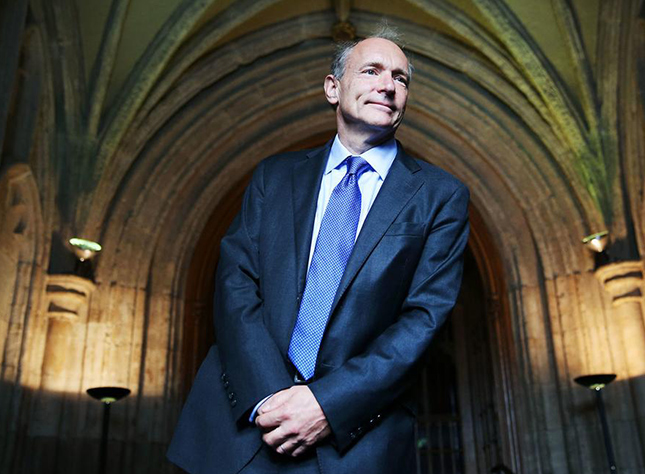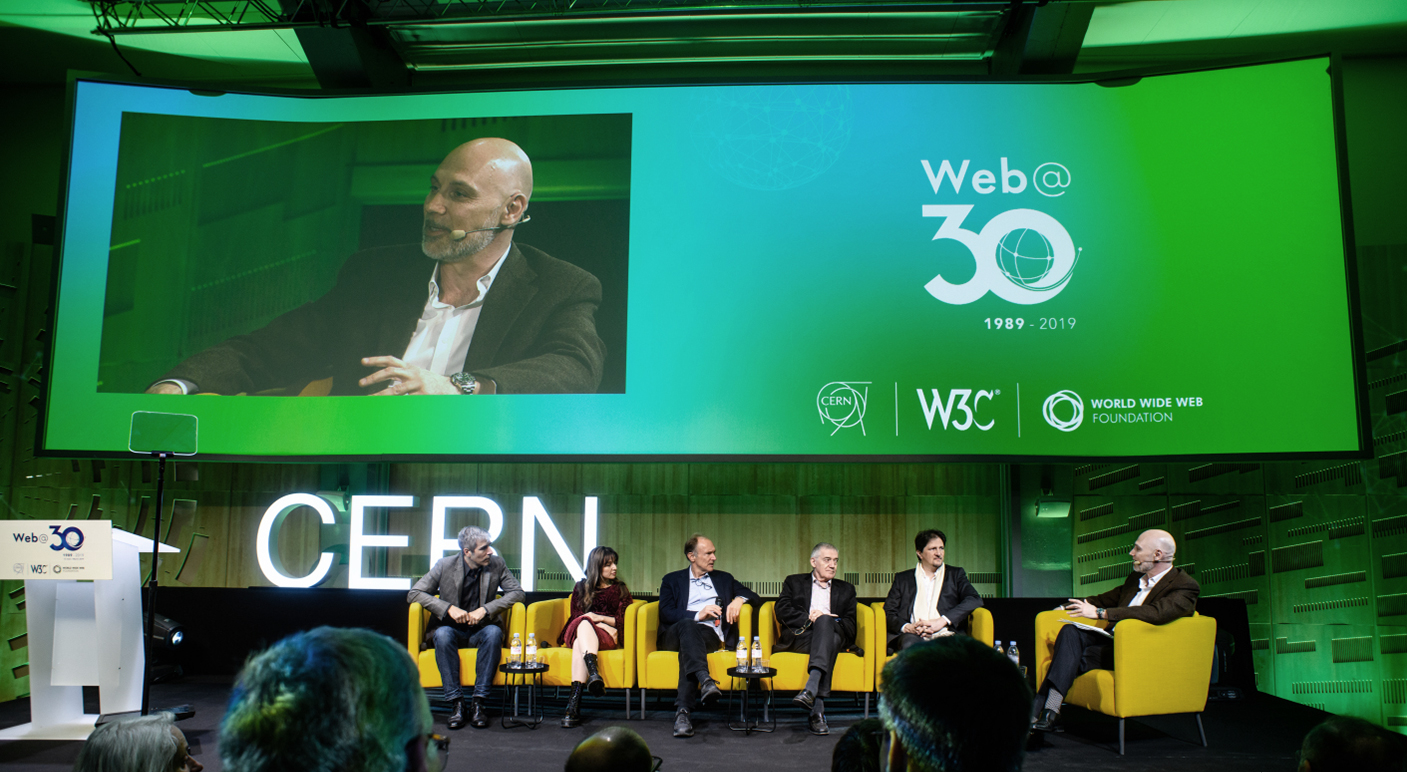VOL.52
May 2019


Special ____ The Beginning of That Brings the World Together
World Wide Web,
the Beginning of the Connection That Brings the World Together
The Internet is a huge computer network that connects the whole world. The technology behind this is the World Wide Web, which connects information and provides every person access thereto. Simply put, it is the collection of web pages that we come across on computer networks. March 12 marked the 30th anniversary of the World Wide Web, which has brought the world together into a single large circle, where anyone can navigate to wherever they want.


Tim Berners-Lee, the inventor of the World Wide Web © CERN
How Did the World Wide Web Come into Being?
Today, we can easily access various web pages provided by portal sites, such as Naver and Daum, and this is all possible because of World Wide Web technology. Before the technology was developed, the Internet was implemented using telephone lines (PSTN) and telephone modems, also known as PC Communication. Chollian, Hitel, and Naunuri were then major service providers. The service was accessed by calling given phone numbers that typically started with 0141x, and the speed was in the range of 2,400~14,400 bps. As of 2017, over a year ago, the figure was 127.45 Mbps, giving us a glimpse of how poor the Internet environment was back then. In the era of 5G, where it takes only a few seconds to download a movie, it might be difficult to imagine how patient people had to be to download a single image file. Also, at the time, Internet access charges were calculated in the same way as telephone charges, and thus when connected through long-distance calls, the service charge could go up to hundreds of thousands won. It has already been 30 years since this text-based PC communication environment transitioned into the World Wide Web-based service.
The World Wide Web was first developed by Tim Berners-Lee, a then researcher at the European Organization for Nuclear Research (CERN). He introduced the concept of the World Wide Web that he designed in 1989 to open a web page for the first time in the world. At the time, many researchers across the world were devoted to particle accelerator research, but communication was not easy because each of them used different types of computers and operating systems. In response, the inventor sought to find ways to allow anyone to communicate with anyone else, regardless of what types of computers and operating systems they used. His idea was to connect all the information that was stored in multiple computers across the world through the Internet. Under this scheme, the ownership of information still rested with its original owner, while the utility of the information could be maximized. This was an innovative approach where anyone could access information wherever and whenever they wanted.
The World Wide Web is distinctively characterized by its hyper link function. With this function, users can jump to other web pages simply by clicking on the link given. Simply put, the technology connects all different types of media, such as text, videos, images, and multimedia content, though web browsers and hyperlinks. The technology was as innovative back then as it is familiar to us today, and it has been widely used to date for over 30 years while providing a great deal of convenience.
The CERN
“European Organisation for Nuclear Research”, is the greatest laboratory for nuclear and particle physics in the world. It is situated just northwest of Geneva, Switzerland, on the border between France and Switzerland.


Taking Another Step toward Becoming the Web for All
Tim Berners-Lee brilliantly named his invention the “World Wide Web,” and made it available to everyone. He never doubted his decision despite many people arguing that he had to protect his idea by securing a patent for it. As it stands now, it is not an exaggeration to say that humanity would not have enjoyed this Internet revolution if it were not for his unwavering faith, i.e., dreaming of a world where information is equally shared by all. Thirty years from the invention of the World Wide Web, Tim Berners-Lee says, “The Web we see today is not what we wanted it to be.” He argues this point because he thinks that the World Wide Web no longer benefits the world as initially intended, i.e., allowing everyone to have access to information in an unrestricted and fair manner and promoting the decentralization of power. Berners-Lee then points to three factors as having negatively affected the Web. The first factor is intentionally malicious online behavior. He pinpoints hacking and online bullying, and especially malicious actions that are conducted by individual countries. He then argues for the urgent need to revise laws to ensure that unjustifiable behavior can be properly marked to the extent that the openness of the Internet is not harmed. The second factor is the advertisement-based profit models of ICT giants such as Google and Facebook. This profit-making strategy only increases clickbait-like articles and accelerates the spread of inaccurate information. Berners-Lee has long been a critic of large corporations that have made huge profits using private information. The last factor is extreme online disputes, which have unintentionally brought negative consequences. Hate speech and cyberbullying are good examples. Having said that, major platforms such as YouTube, Facebook, and Twitter are making efforts to remove insulting content online.
Seeing Berners-Lee concerned about his own invention, i.e., the global-wide network, makes us hesitate to celebrate its 30th anniversary to the fullest. In cooperation with the Massachusetts Institute of Technology (MIT), the inventor is currently implementing a project titled Solid to achieve his goal of building the Web for all. All data that are contained in the Web are assigned addresses, and the information that shows how those data items are connected to each other is provided. By using the linked data with improved connectivity, the project intends to prevent any companies or countries from monopolizing the Web. By doing so, Berners-Lee is willing to take one step further to protect individual privacy while making clear that the ownership of each data item must rest with its individual owners.

Image of Web experts discussing issues at a memorial conference held at CERN on the 6th of March, right before the 30th anniversary of the World Wide Web © CERN
Invention history of the World Wide Web © CERN
Will the World Wide Web Bring about Another Innovation for the World?
The progress that has been brought about to humanity by the invention of the World Wide Web can be compared to that by the invention of electricity. However, the technology has reached a plateau with the unfolding of the mobile revolution. In 2007, Steve Jobs at Apple released the iPhone. In 2008, when the world was struggling with the financial crisis starting in the US, the iPhone 3G, which was compatible with 3G networks, was unveiled. In 2009, the iPhone 3GS was released, and transformed the world through the mobile revolution. Finally, in November of the same year, these iPhone products, which were then seen as more of something that would exist in the virtual world, entered the Korean market for the first time.
The mobile revolution was followed by disputes over the Web and apps. This was because the emergence of the smartphone opened the door to the era of apps. Web browsers were then accessed more on smartphones than on PCs, and web browsers gave way to portal apps as the main search platform. Today, people order their drinks at cafes using the Siren Order and enjoy app-based food delivery services. Having said that, these app services also use Web technology, but it is admittedly true that the advancement of Web technology that is represented by web browsers has reached a plateau with the mobile revolution.
With web browsers, you cannot order foods or call a taxi. Even though this is the case, the intrinsic value of the Web will never disappear. Once developed, web pages can be accessed regardless of the type of operating system and browser used. Also, Web technology provides a channel, i.e., searching, through which providers can meet users. In contrast, apps have limitations in that they must be developed separately for each user environment.
Dr. Lee, Seung-Yun, who serves as a principal researcher at ETRI’s Service Standards Research Section and the head of the W3C Office in Korea, said, “As it stands, the Web may change in unexpected ways going forward. Therefore, now is the time to prepare for the next 30 years, in which the Web will continue to evolve, and to seriously reflect on its future direction.” The emergence of the World Wide Web has significantly improved the mobility of information and given rise to new types of companies. As a result, many jobs have been created, and the use of collective intelligence has been significantly promoted. Along with this trend, the era of communication has started, where communication is no longer limited by information and knowledge barriers. On the flip side, however, lie the concerns raised by Tim Berners-Lee, e.g., privacy violation and the abuse and misuse of the Web. Nevertheless, we expect that the World Wide Web, one of the most innovative inventions of the 20th century, will ceaselessly evolve and serve as a useful tool that will benefit our future lives, providing a new paradigm.



